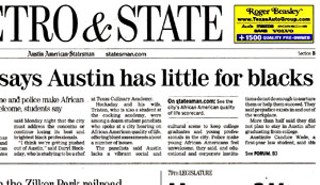'Statesman' Gets Creative
'Statesman' explores new ways to spark circulation and revenue, often taking a pickax to traditional Ad-Editorial boundaries in the process
By Kevin Brass, Fri., April 29, 2005

Jay Yeates is not really interested in the pressures facing the modern daily newspaper. He simply wants the Austin American-Statesman to stop dumping a red-bagged copy of the newspaper on his driveway, which turns into a mushy red mass after it rains. "If I wanted a newspaper I would subscribe to it," said Yeates, 48, a computer network administrator who is tired of picking up the unwanted papers from lawns and storm gutters. "If I'm not paying for it, they are simply littering my yard," he said.
Unfortunately for the Statesman, Yeates is part of a growing population of suburbanites who are finding that life can still be a rich and wonderful experience without a daily newspaper. Around the country, urban papers are losing readers, even as metro populations soar. Although the regional population is growing rapidly, last year alone the Statesman's Monday through Saturday circulation slipped from 183,312 to 177,926 copies a day, according to reports filed with the Audit Bureau of Circulations.
Faced with the stark numbers, the Statesman is exploring new ways to spark circulation and revenue, often taking a pickax to traditional boundaries in the process. Most glaring was the introduction in recent months of color ads in the section front headers – once sacred turf. If they choose, advertisers now can also buy a "post-it note"-style ad on page one or strip an ad across the bottom of a section front. "They are trying to be more creative," said one local advertising executive, who didn't want to be named.
The bagged copies showing up on Yeates' driveway are part of an attempt to boost the Statesman's official circulation numbers using "sponsored" copies, a controversial practice within the industry. In 2001, faced with pressure from publishers, the Audit Bureau changed its rules to allow newspapers to include so-called third party copies in their overall numbers. The third-party copies are typically purchased at a cut rate by sponsors and distributed free to unsuspecting nonsubscribers like Yeates, who may or may not feel blessed by the free newspaper. A study by The New York Times last year found that 669 of the nation's top papers would have reported an additional 2% decline in circulation if the third party freebies were excluded.
After complaints from advertisers and circulation scandals at several large dailies, some newspapers have pledged to cut back on the freebies. "If the pendulum is swinging, it is swinging away from aggressively pursuing third-party sales," said Sammy Papert, CEO of Dallas-based Belden Associates, a newspaper research firm.
Bucking the trend, the Statesman is actually increasing its third-party sales. The Statesman's 2003 paid circulation report includes more than 17,000 copies for "educational programs," "employee copies," and third-party sales; a year later the number was up to 18,500, helping to soften some of the drop in actual paid circulation.
Statesman publisher Michael Laosa says the Statesman is following the "letter" of the new policy, which also restricts the percentage of third-party sales that a newspaper can use in its overall numbers. Third party sales "are OK as long as you follow the rules set out by the [Audit Bureau]," he said.
Like many papers, the Statesman is trying to downplay its circulation numbers. In a March 13 column introducing a new blog, Statesman editor Rich Oppel wrote that "as print newspapers plateau in terms of paid circulation," the Statesman and other papers "now think in terms of readership." In other words, after decades of preaching the value of their paid circulation, newspaper executives now say it's much more important to look at how many people are reading the paper, not how many are paying for it.
According to the "readership" theory, the flagship paper's circulation may be sliding, but actual readership is increasing, thanks to the paper's Web site and niche products, like the Statesman's new Hispanic-targeted paper, Ahora Sí!. "I think the industry has to move the market, to some degree, to readership," Laosa said. "We've done fairly well compared to the rest of the world when you look at our readership numbers."
Readership is the new mantra of the industry. "If you have lemons, sell lemonade, and basically readership is the lemonade and circulation is the lemon," said John Morton, president of Silver Spring, Md.-based Morton Research Inc., a consultancy whose clients including Cox Newspapers, parent of the Statesman.
Despite steadily decreasing circulation numbers over the past 20 years, newspapers have remained profitable, Morton notes. Last year, publicly owned publishers reported profit margins of more than 20%, he says, thanks in part to declining cost of newsprint and, in some cases, slashing jobs. They've also managed to pass on costs to their clients by raising advertising and subscription rates. The days of a 25-cent newspaper are long gone.
The Statesman, which costs the now-standard 50 cents, has steadily increased its ad rates in recent years, advertisers say, despite the lagging circulation. And advertisers are still willing to pay for choice locations. The price of a full-color "sky box" ad on the section front is $750, according to advertisers, although the price plummets as low as $200 a day if an advertiser buys in bulk. Ads stripped across the bottom of a section front – another recent introduction – cost $3,000 a day. "I think all newspapers are realizing that advertisers are looking for out of the box opportunities," said Kasey Kamerman, print buyer for GSD&M, the Austin-based ad agency.
But some newspaper industry experts question if papers are offering up too much prime real estate to advertisers. "I think it cheapens the product, that's my view," Morton said. "It should always be clear to a reader what's for sale and what isn't."
Within newsrooms, there is always concern that, as lines blur, advertising concerns will play a larger role on editorial pages. A few months ago Michael Barnes, editor of the Statesman's weekly entertainment guide XLent, raised proverbial eyebrows when he sent an e-mail to local arts organizations – the same organizations he covers – that appeared to urge them to advertise in an upcoming issue of XL. (Oppel and managing editor Fred Zipp didn't return calls for this story; Barnes declined to comment.)
But Laosa says nothing has changed. While ads may be going where they've never gone before, the ratio between advertising and editorial content in the paper is essentially the same, he says. "As far as we're concerned, the line is the same," Laosa says. "Advertising takes care of advertising and news takes care of news."
The Statesman is not alone in its efforts to find new ways to make the newspaper business pay off. There is a sense that the old rules are gone. One idea being discussed in other markets is so-called "shadow" advertising, watermarks that will be visible underneath features. In the near future, newspapers will have to approach business in a "more consumer-centric way," Papert said. "It would be crazy not to realize times change."
Got something to say on the subject? Send a letter to the editor.








